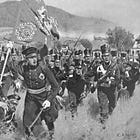This is the thirteenth post in a multi-part series. To find previous installments and those that follow, please consult the following guide.
While the 1st Regiment had entered action as I have described, with every prospect of a successful preparation for the charge, a tremendous fire opened suddenly on our left flank.
The 1st Battalion of the 2nd Regiment had advanced on the left rear of the 1st Regiment, and had deployed into a formation similar to that of the first two battalions of the 1st Regiment. Its firing line was originally about 800 yards behind that of the 1st Regiment.
Being excited, however, by the commencement of the fight by its comrade regiment, and perhaps also urged forward by the shots that fell in its ranks, it kept on continually pressing more and more to the front; consequently, its firing line was almost a prolongation of that of the 1st Regiment, but with an interval of 200 yards between them even before the battalion reserves of the 1st Regiment had come into action.
The battalion had now to change front half right in order to take part in the action. But before it could do so it had to employ all its strength in repelling an energetic counter-attack of the enemy, which was directed obliquely against the left flank.
A short and extremely hot action ensued. The firing line of the battalion wheeled half left by platoons, and then advanced by companies to its new front. Thick swarms of the enemy’s skirmishers had advanced to within 300 yards of the foremost company before its volleys could stop them. A heavy fire from both sides now began.
Our battalion, however, did not confine itself to the defensive. Ground must be won, if the danger to the left flank of the comrade regiment was to be altogether removed. After the firing line had been reformed from the echelon-like formation which resulted from the wheeling half-left, the supports were thrown into it, and a combined advance of the two companies drove the enemy’s firing line back. We pushed on about a hundred yards, and were then forced to halt and recommence firing against fresh bodies of the enemy.
In the meantime a company from the battalion reserve had prolonged the firing line to the left, as the enemy’s fighting line dangerously overlapped this flank. The enemy, however, gradually developed an overpowering strength, not only in front, where his repeated advances of fresh troops were shattered by our deliberate volleys, but also, in a much more dangerous way on our left flank. On this side the enemy was continually extending his right flank. Swarm upon swarm of fresh troops kept on springing up unexpectedly from the covering folds of the ground, and endeavoring to envelop the flank of the battalion. First the 2nd Battalion, and then, as the great superiority of the enemy became apparent, the 3rd Battalion also were moved up to the support of the firing line from the brigade reserve, which was behind some copses, about 1100 yards in rear.
The approach of these reinforcements had clearly only the effect of inciting the enemy to hasten his efforts to overthrow the still isolated 1st Battalion. The swarms on his right flank began to charge. The few platoons of our battalion which had formed a defensive crochet on this side were already in confusion, and the control over their fire was lost. Something must be done at once, and the battalion commander did not hesitate to throw in his last reserve. The 4th Company, under the battalion leader, advanced cheering, with fixed bayonets, color flying, and drums beating, against the right flank of the enemy, forcing back his firing line right and left.
But the enemy was too strong. The magazine fire of fresh masses, who rose behind the panic-stricken skirmishers, shattered our ranks. Thrice sank the color, thrice it rose again and went forward. The forth time it fell without rising again, and over it fell a number of officers and men. All was in confusion, and when from amid the enemy’s smoke a dark mass emerged shouting, our few remaining men took to flight.
The fate of the battalion was sealed in a minute. The 2nd Battalion had, by making all possible haste, arrived within 200 yards of the scene of disaster, but as the greater part of the 1st Battalion was between them and the enemy it could give no help by firing. The 3rd Battalion had succeeded in directing its march more to the left, and had opened fire on the enveloping right flanks of the enemy. The range was so great, however, that the only effect of its firing was to prevent the further extension of the enemy’s flank to the right.
‘Unfortunate regiment!’ I exclaimed; ‘one battalion is shattered, and the second will be carried away by the flight of the first.’
There was every prospect of this. The firing line of the 1st Battalion continued to advance, instead of throwing itself down so as to allow the fugitives to pass through it, and then open fire. Clearly the chief object was to reach the point where the color of the unfortunate battalion lay under a heap of dead and wounded who were crawling away; or, at least, to prevent the enemy’s reaching this point. Under such circumstances, to halt was impossible, and the danger of being run away with or being thrown into confusion by the fugitives was not so great as I had imagined, I had not reckoned on the power of the close order.
To be continued …
Soon after an installment of this series appears in the pages of The Tactical Notebook, a link to it will appear on the following guide.






